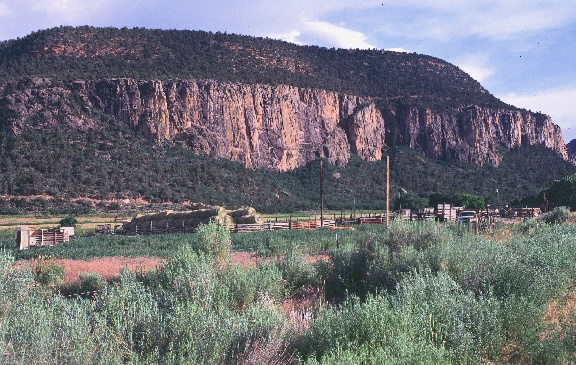
Unaweep Canyon
Go to MORE
PHOTOS FOR Unaweep Canyon?
Overview of this Site
Unaweep Canyon,
located in southwestern Colorado, cuts through the Uncompahgre Plateau. The
Uncompahgre Plateau was once part of the Ancestral Rocky Mountains, a series of
mountain ranges that were first uplifted during the Pennsylvanian Period in
about the same geographic location as the modern-day Rocky Mountains. The
Uncompahgre Uplift is composed of Precambrian granite and granite-gneiss that
is cut by immense dikes. It has an extremely flat top that is directly overlain
by Triassic age sedimentary rocks (Chinle Formation). Above the Chinle, the
resistant rocks along the skyline are the Jurassic Wingate Formation.
The
Uncompahgre is significant to the geology of southeastern Utah because it acted
as the source of much of the clastic sedimentary rocks that now form the
canyons and plateaus of southeastern Utah's National Parks and Monuments. There
is some evidence that uplift of the Uncompahgre during the Pennsylvanian may
have resulted in flexure of the Earth's lithosphere and depression of the
Paradox basin (located in southeastern Utah). Today the Paradox basin is an
important area for oil and gas exploration and development.
To
get to Unaweep Canyon from Grand Junction, Colorado, take Horizon Drive west to
12th Street, turn left on 12th Street, pass Mesa State College, turn right at
North Street (at the south end of Mesa State College). From there turn left on
1st Street then turn left onto Highway 50 east (also Interstate 70 Business
east). Nine miles later, a right turn lets you continue on Highway 50 east. At
the town of Whitewater turn right onto Highway 141 west (toward the town of
Gateway). Travel on Highway 141 about 14 miles until you reach Divide
Road. Divide Road takes you up the south side of Unaweep Canyon.
As
you drive from Grand Junction into Unaweep Canyon you travel downsection, that
is, into progressively older rocks. As you enter Unaweep Canyon the 1st
prominent sandstone you pass is the Cretaceous Dakota Sandstone, which is
whitish grey in color. The second prominent sandstone is the Triassic Wingate
Sandstone (red color).
![]()
Return to Geology of Utah's National Parks Home Page
Return to Introduction to Photos Page
![]()